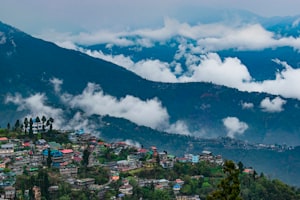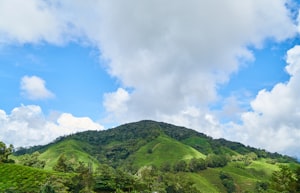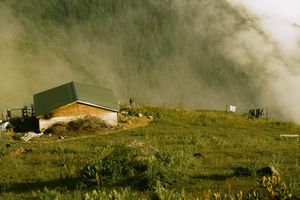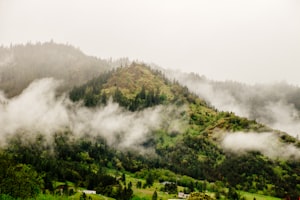Discovering Darjeeling: A Himalayan Gem
Explore the beauty and history of Darjeeling, a picturesque hill station in India. Learn about its origins, diverse culture, climate, and more.
Oct 19, 2023 3 mins

TOC
Nestled in the northern part of West Bengal, India, lies the picturesque hill station of Darjeeling. This enchanting destination boasts breathtaking views of the snow capped Kanchenjunga, cascading mountain streams, lush tea gardens, and a landscape adorned with rhododendrons, orchids, and ferns. The region's diverse flora and fauna, including red pandas, pangolins, and leopards, offer a glimpse of the natural wonders that Darjeeling has to offer. Alongside these, Darjeeling is home to a rich tapestry of cultures, with Nepalis, Tibetans, and Lepchas creating a warm and welcoming atmosphere.
Exploring Darjeeling's Origins and Legends
The name "Darjeeling" itself carries a fascinating history. One popular legend attributes it to the area's tendency to attract thunderstorms and lightning, with "Dorji" in Tibetan meaning "thunderbolt" and "Ling" signifying "place." Thus, Darjeeling is often translated as "The place of the thunderbolt."
Another account traces the name's origin to the chief monk of a monastery that once crowned Observatory Hill. His name, Rinzing Dorji Legden La, led to the area being called "Dorji-Ling," which over time evolved into Darjeeling. In Sanskrit, "Durjay Ling" means "Shiva of invincible prowess who rules the Himalayas," suggesting another source of the name's inspiration.
A Glimpse into Darjeeling's History and Geography
Darjeeling's history stretches back to the 1700s when it was part of Sikkim under the Raja. Subsequently, the region came under Gorkha rule from Nepal, only to be restored to Sikkim by the British in the early 1800s. It was the British who envisioned Darjeeling as a sanitarium, creating a health resort for European troops. Since then, Darjeeling has evolved into a thriving hub of agriculture, education, and power.
Geographically, Darjeeling is nestled in the northern part of West Bengal, sharing borders with Sikkim to the north, Bhutan to the east, and Nepal to the west. This location provides a panoramic view of the Himalayan snow peaks, making Darjeeling a coveted destination.
Darjeeling's Three Tiers of Charm
The layout of Darjeeling town is akin to three distinct tiers interconnected by steep, narrow roads. At the topmost tier stands Chowrasta Mall, the town center, offering commanding views and hosting popular hotels, restaurants, and shops. The middle tier encompasses areas like Laden La Road and HD Lama Road, offering a more affordable stay while still providing stunning vistas. The lowest tier, or bottom level, is where you'll find bustling places like Chowk Bazaar, where the local culture truly shines. Here, you'll encounter a medley of Nepalese, Tibetans, Lepchas, and Bhutias, with budget-friendly accommodation options.
Darjeeling's Climate: Four Seasons of Enchantment
Darjeeling experiences a varied climate throughout the year, each season exuding its unique allure. Summer, from May to June, offers pleasant temperatures and clear skies. The monsoon season, spanning from July to September, brings copious rains, fog, and overcast skies. Autumn, in October and November, greets visitors with pleasant weather and clear vistas. Winter, from December to February, ushers in cold temperatures and excellent visibility. Spring, throughout March and April, offers a cool and temperate climate with clear skies and mountain views.
Reaching Darjeeling: The Journey Begins
Darjeeling does not possess its own airport or railway station. The nearest airport is Bagdogra, while the closest major railway junction is New Jalpaiguri (NJP). From these points, visitors embark on an 80-kilometer uphill journey to reach Darjeeling. The drive takes around three hours, but one can also opt for a leisurely seven-hour toy train ride from NJP, an experience that showcases the scenic splendor of the region.
The Tapestry of People and Culture
Darjeeling is a melting pot of cultures, as immigrants from neighboring regions have settled here. The predominant population consists of Nepalis who follow Hinduism, while Tibetans practice Buddhism. Christianity is also prevalent in the region, reflecting the diverse heritage of its inhabitants.
Festivals and Celebrations
With such a diverse array of residents, Darjeeling's festivals are as varied as the people who celebrate them. From Dashain and Tihar, major Nepali festivals, to Losar, a Tibetan New Year celebration, and Christmas, the town thrives with festivities throughout the year.
Local Cuisine and Beverages
The region's ethnic diversity is mirrored in its culinary offerings. From Nepali thalis to Tibetan delicacies like Thukpa, and local snacks like momos, Darjeeling's food scene is a fusion of cultures. While tourist restaurants serve international cuisine, seeking out traditional food stalls offers an authentic taste of Darjeeling.
Darjeeling Tea: A Steeped History
The story of Darjeeling tea is a captivating one. The British sought an alternative location to cultivate quality tea, leading them to Darjeeling. Known as the "Champagne of teas," Darjeeling tea is now a world-renowned industry. This section delves into its history, the various tea types grown in Darjeeling, the tea estates available for tours, the best places to purchase Darjeeling tea, and how to brew the perfect cup.
The Darjeeling Himalayan Railway: A Journey Through Time
The Darjeeling Himalayan Railway, also known as the Toy Train, dates back to the 1800s when it was engineered by the Royal Engineers. This narrow-gauge railway connects the plains with Darjeeling hills, taking passengers on a captivating seven-hour journey filled with breathtaking landscapes.
Flowers and Plants of Darjeeling
In spring, the hills of Darjeeling come alive with vibrant flowers like rhododendrons, orchids, and magnolias.



